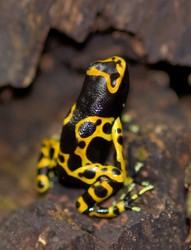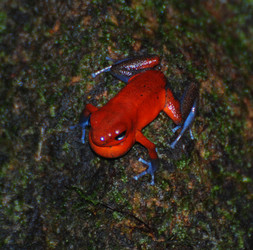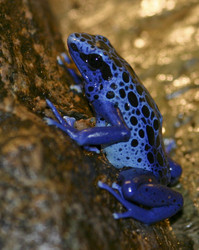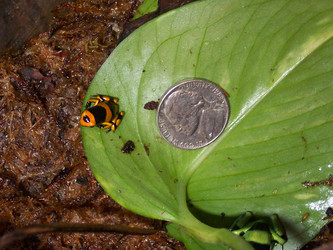



Poison Dart frogs: Dendrobates leucomelas, the yellow-banded poison dart frog (© 2007 Danny Barron), Dendrobates pumilio, the strawberry poison dart frog (© 2008 Jerry Oldenettel), Dendrobates azureus , the blue poison dart frog (© 2008 Brian Gratwicke).
Introduction
Dendrobates are amphibians and are members of the family Dendrobatidae. They are most recognized for their extravagant colours that warn potential predators of their highly toxic defensive chemistry. Their common names are the Poison Dart Frogs or Poison Arrow Frogs.
Classification
The poison arrow frogs are classified as follows:
- Kingdom: Amimalia
- Phylum: Chordata
- Subphylum: Vertebrata
- Class: Amphibia
- Order: Anura
- Family: Dendrobatidae
- Genus: Dendrobates
There are ten species belonging to genus Dendrobates. The most common are Dendrobates auratus, the green and black poison dart frog, Dendrobates azureus, the blue poison dart frog, Dendrobates histrionicus, Dendrobates lehmanni, Dendrobates leucomelas, the yellow-banded poison dart frog, Dendrobates pumilio, the strawberry poison dart frog, and Dendrobates tinctorius.
The class Amphibia includes other tetrapod organisms such as salamanders and toads. Amphibians are ectothermic and do not have amniotic eggs. The name of the order Anura translates to “without tail,” a characteristic that is recognized as a synapomorphic trait of frogs and toads. The specialized fusion of their bones in the tibia and fibula is also a synapomophic character state that supports jumping in frogs and toads.
Evolution
Dendrobatids are neobatrachians. Within this group, the position of Dendrobatids has been a subject of debate. Some authors have placed dendrobatids in Bufonoidea and some in Ranoidea. The most recognized is the latter. Dendrobatidae share several synapomorphic traits with Ranoidea, such as their cartilaginous sternum, horizontal pupil and unnotched tongue.
Distribution and Habitat
Dendrobates are found in various regions of Central and South America in countries such as Nicaragua, Costa Rica, Brazil, Venezuela, Ecuador and Colombia. Dendrobates auratus, can also be found in Hawaii, where it was introduced by humans and thrived.
Dendrobates are restricted to locations where the humidity level is extremely high. Most frogs are terrestrial and live in damp leaf litter on rainforest floors, but some are arboreal and climb trees very easily. Poison arrow frogs very rarely go into water, except to lay their eggs.
Physical Characteristics
Poison arrow frogs are brightly coloured. The colours vary between the species. Some are red, yellow, orange or blue, and they often have striking stripes or crossbars. The organisms are extremely small in size; they reach a maximum length of only 2-5 cm. Dendrobates weigh only a few grams.


Picture illustrating the small size of a yellow-banded poison dart frog, Dendrobates leucomelas (© 2003 B Smith)
Dendrobates skin glands, particularly those located on the back and the ears of the frog, produce an extremely strong neurotoxin known as batrachotoxin which affects the nerve impulses and the heart of prey.
Behaviour
Feeding
The frogs’ main sources of food are small insects (e. g., ants), mites, and spiders. They are often lured to the frog by their extravagant colours and then are poisoned by toxins produced in the frogs’ skin glands. The prey dies almost instantaneously, and frogs then orally ingest them. Some researches have suggested that skin toxins of the frogs are derived from precursor molecules found in their prey.
Predation
The combination of the poison dart frogs' colouration and diurnal habit reduce the risk of predation on these organisms. Dendrobatids only have very few predators. Several species of snakes in South America are capable of eating these frogs because they are not affected by the poison that the frogs produce.
Reproduction
Courtship and Mating
The mating season for the poison arrow frogs is during the rainy season of the rain forests, from about mid-July to mid-September. The male poison arrow frogs go through quite an elaborate ritual to attract the females. They fight amongst themselves to establish territories, which remain theirs until the end of the mating season. The male then attracts females through vocalization, by letting out a loud trill.
Nesting
Once the male has successfully completed the courtship ritual, females can lay up to six eggs which they normally do in small lukewarm pools of water at the brim of leaves, high on the canopy in a safe place. The male frogs then go and fertilizes the eggs. The eggs are protected from decay by a gelatinous substance which encases them.
Development
After the eggs are laid in a save location, the male frog returns to the eggs periodically to check on them. It takes about twelve days for the eggs to hatch into tadpoles. Once the tadpoles are hatched, they climb onto the male's back where he will carry them to a safe location such as a stream, a lake, little ponds or even broken trees and branches for them to continue their development. There, the frogs are now on their own and take an average of six to twelve weeks to metamorphose into full adult frogs.
Interesting Facts
- The Embera Choco people of South America used to coat their weapons such as darts with the frogs' toxin.
- The National Institute of Health claims that the poison dart frogs have over three hundred alkaloid components similar to cocaine and morphine. Batrachotoxin has already been used in anesthetics in surgery.





 Go to quick links
Go to quick search
Go to navigation for this section of the ToL site
Go to detailed links for the ToL site
Go to quick links
Go to quick search
Go to navigation for this section of the ToL site
Go to detailed links for the ToL site